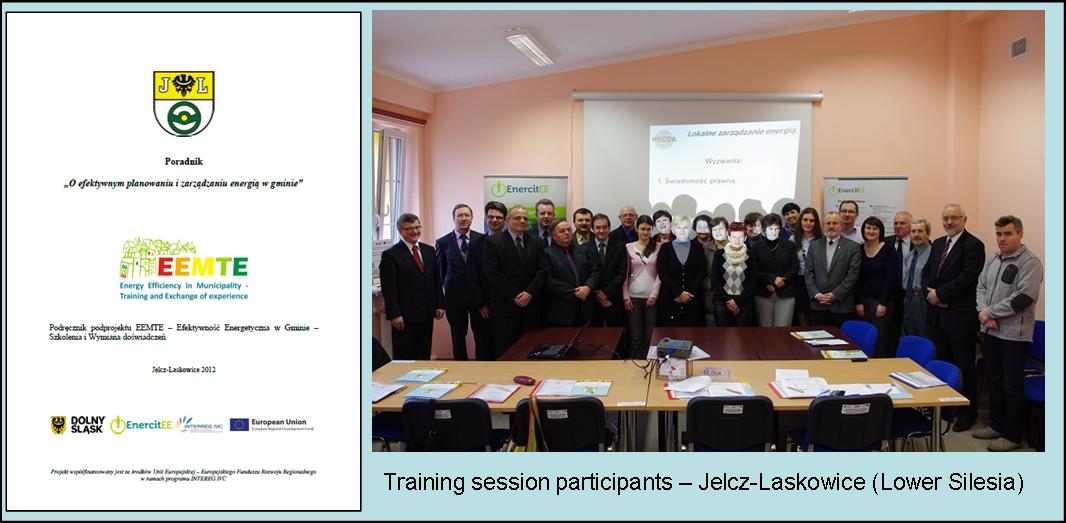Newsletter
- Issue VIII / November 2013
- Issue VII / June 2013
- Issue VI / February 2013
-
Issue V / June 2012
- Editorial: Important milestones have already been reached within EnercitEE
- EnercitEE’s Policy maker exchange – mayors from 4 European countries shared the vision of Växjö
- 2nd EnercitEE symposium
- EnercitEE’s Policy Advice Seminar
- EnercitEE’s Good Practice Guide now available
- First outputs from 1st call sub-projects
- News from EnercitEE’s sub-projects from the 2nd call
- EnercitEE Publicity material
- Upcoming events
- Issue IV / November 2011
- Issue III / July 2011
- Issue II / January 2011
- Issue I / September 2010
News from EnercitEE’s sub-projects from the 2nd call
2nd interregional E-FoxES meeting in Annecy, France
In January 2012 the E-FoxES partnership has held the sub-project midterm meeting. Prioriterre, one of the three sub-project partners hosted the meeting in Meythet/Annecy. The sub-project was reviewed starting with the presentation of the latest project event in the town hall of Bautzen. Prioriterre introduced to the school network involved in the project implementation in Haute Savoie. The third Sub-Project Participant Energikontor Sydost showed some school experiments concerning energy conversions. The partnership agreed about the next steps of the project implementation in the three partner regions. Finally for the study visit the Prioriterre passive house was explained by an expert.

ActEE – 9 communication tools dealing with energy efficiency
Following meetings and exchanges, ActEE’s partners (Mountain Riders, DAPT, Regional Development Agency “ARLEG” S.A.) have chosen 9 communication tools dealing with energy efficiency. One of them, called “Eco Guide to mountain resorts” evaluates resorts actions in terms of sustainable development in France and all over the world according to several themes. This tool facilitates customers’ choice, gives examples of positive actions, and helps professionals to define the scope of sustainability in mountain resorts. All good practices chosen combine positive attitudes, innovative communication tools, people involvement with scientific approaches and contents. The next meeting is planned in October 2012 to optimize the exchange of experiences and further share the knowledge of different communication tools.

GRACE – Analysis of funding programs for citizens and communities
In Germany and especially in Saxony there are many funding programmes which support the energy efficiency of citizens and communities. Within the EnercitEE sub-project GRACE three funding programmes will be analysed in detail. The aim is to find out the effect of the programmes in that way that we are able to make a statement how many CO2 emissions respectively energy is saved with 1 € out of the funding programme. One of the selected programmes is the Saxon Passive house programme. It is part of the Saxon Energy and Climate Protection Programme. During a study visit, organised by Bautzen Innovation Centre, different types of passive houses were visited.

The visited single family passive house in Bautzen is still under construction, but the family is already living there. The flat has an area of 137.5 m². For the future it is planned to install solar panels for producing enough energy for the whole house.
Article in full length on the EnercitEE blog.
EEMTE – New manuals and training concepts for city officials
Manuals, training concepts, seminars and workshops for officials: these are the first results of the EEMTE sub-project. The Commune of Jelcz-Laskowice (Lower Silesia) as the lead partner of EEMTE prepared a guide “On effective planning and management of energy in the commune”.

This guide is a compendium of knowledge on energy efficiency for each employee of local administration and provides the basis for training sessions, lectures and workshops conducted by the project. In various forms training activities in the EEMTE sub-project have been attended by over 200 participants so far – local administration employees from Saxony, Haute-Savoie and Lower Silesia.
FIPREC - 10% of total energy expenditure could be saved
Practically 10% of total energy expenditure could be saved in every community, without any major problems, by using economic investments like Energy-Saving Contracting (ESC). In most cases even more saving is possible. A good German example is the town of Schwabach (population about 39,000) in Bavaria. This commune is saving approximately 130 000 € per year, because major properties have already been modernized by ESC-measures over 10 years ago. Finally, these measures are a very good way for each community to take climate protection seriously. Therefore FIPREC shows current ESC-examples in workshops and will finally illustrate those in a brochure with additional European funding models.

